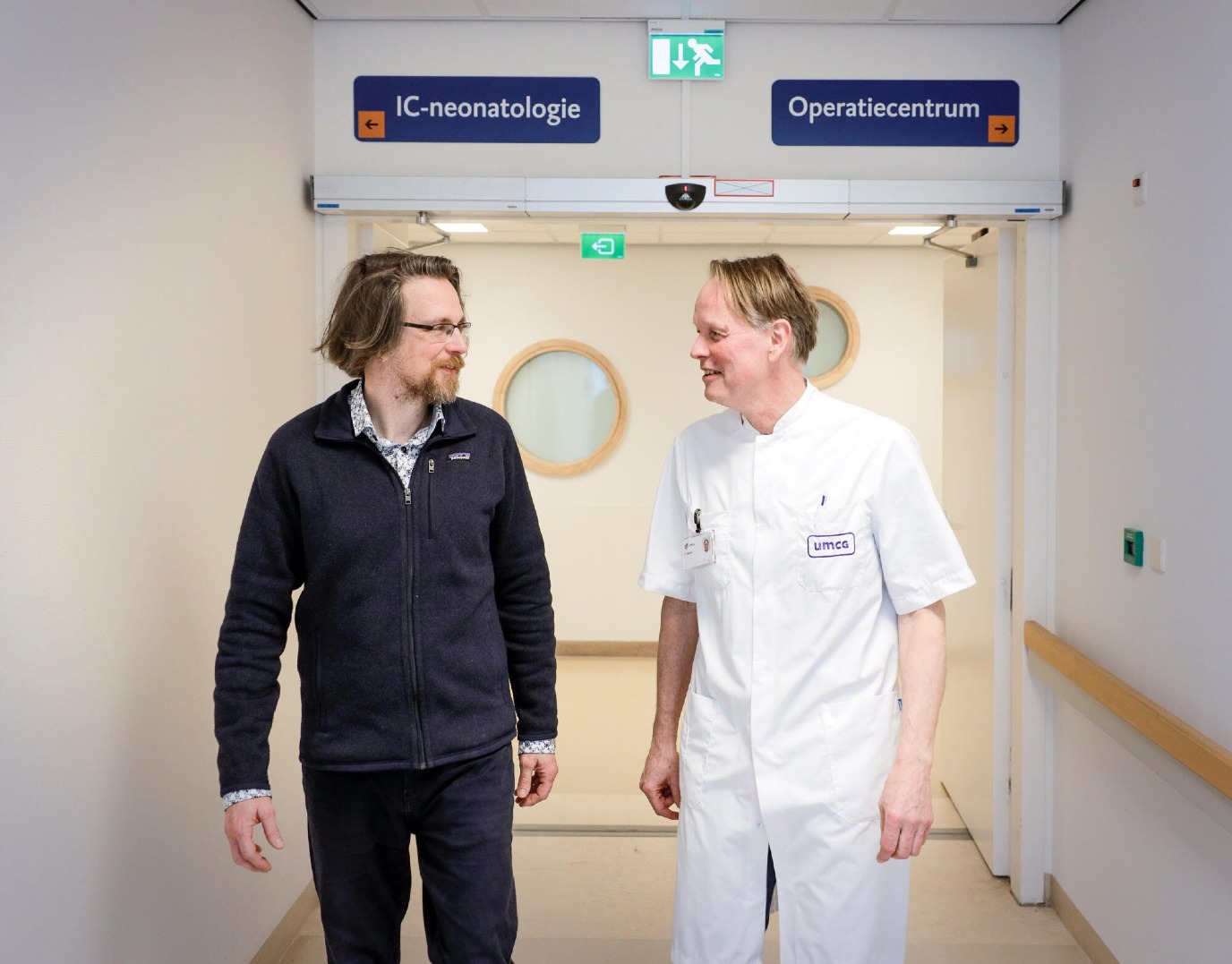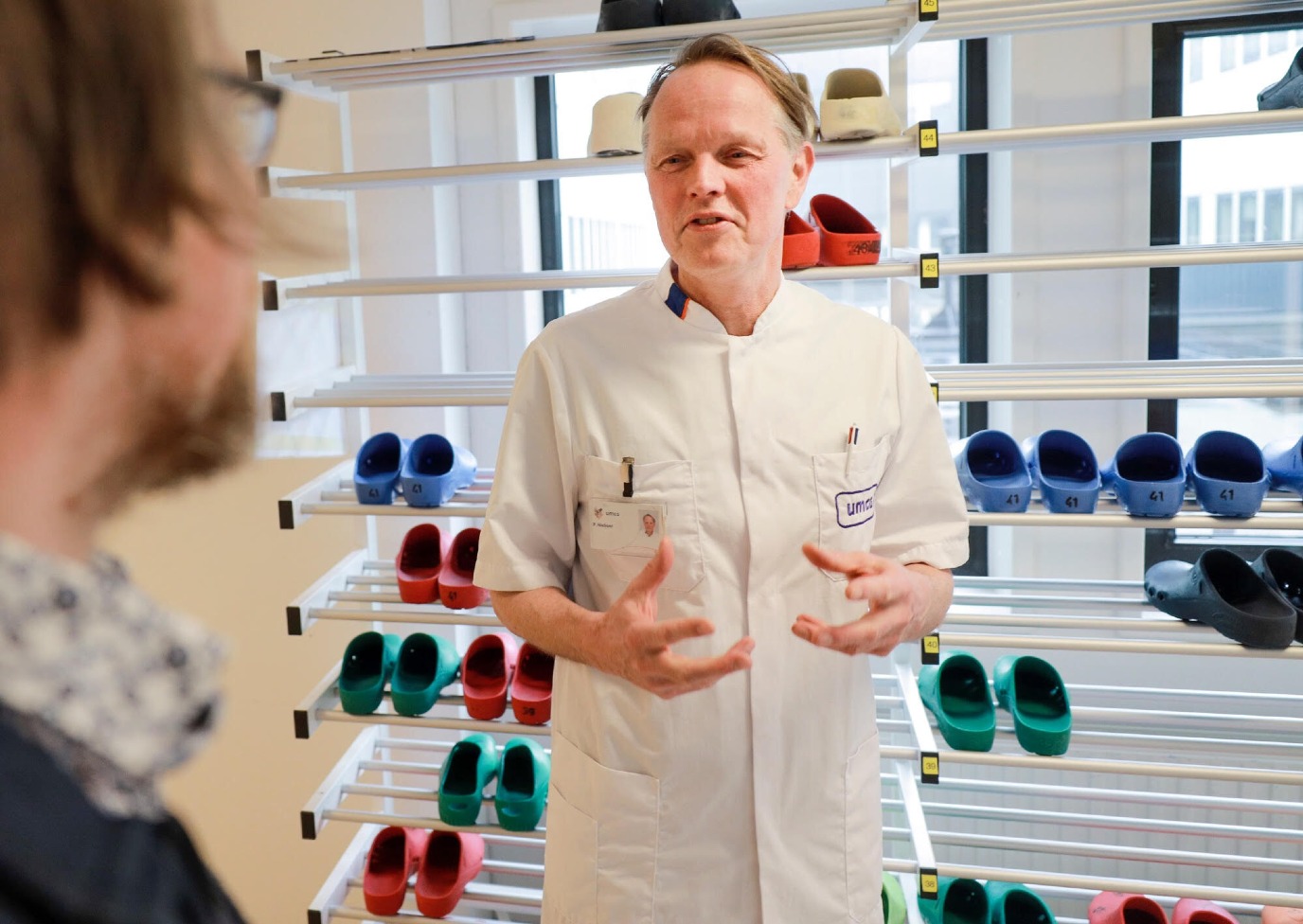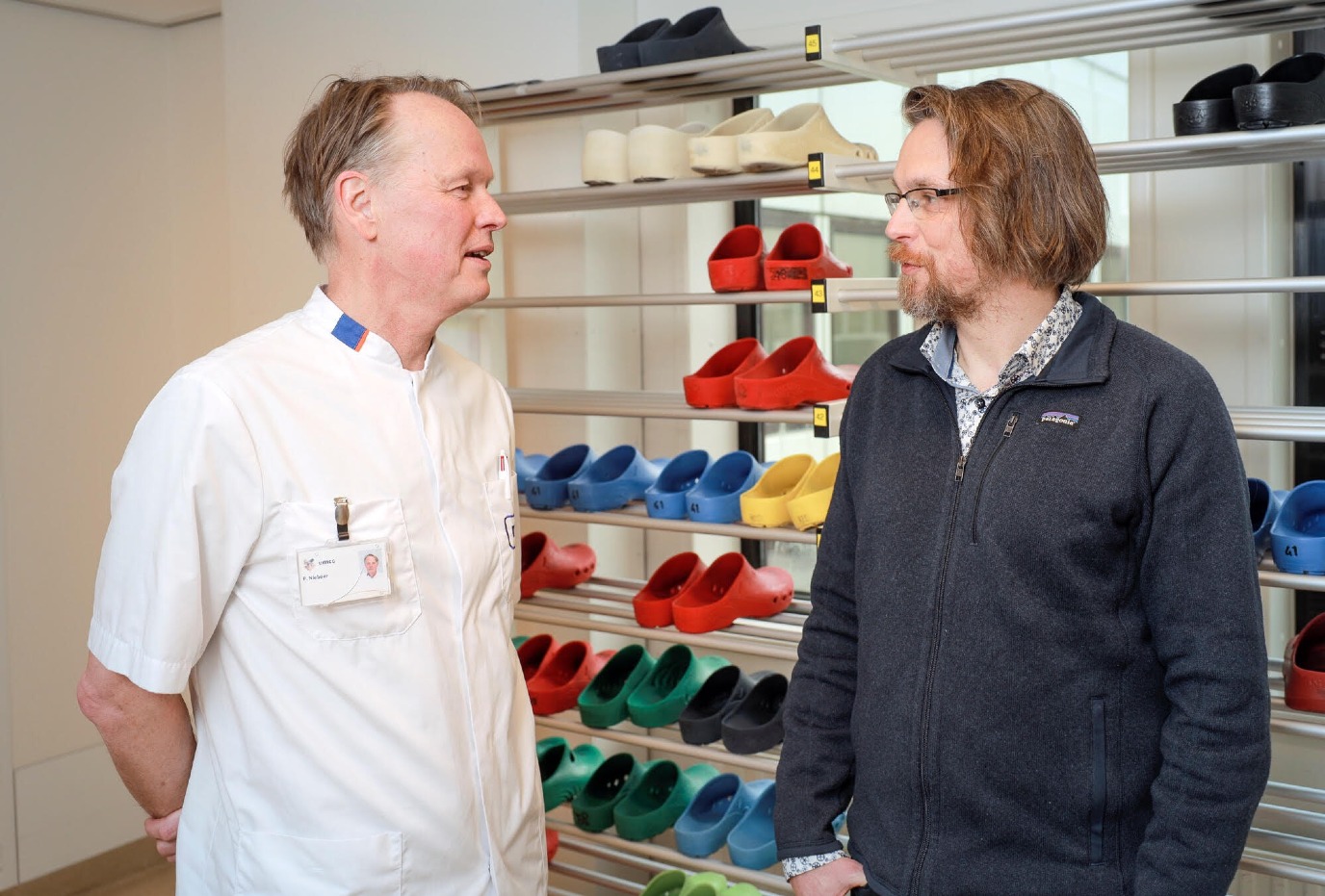Learning to communicate in the operating theatre
The characters: a surgeon and a doctor following specialty training (AIOS). The setting: an operating theatre and on the operating table lies a patient under anaesthesia. The AIOS is operating, the surgeon is supervising. Three cameras record what is happening with the goal of unravelling the mechanisms of on-the-job training. This is the research of a surprising academic duo: Mike Huiskes, associate professor of Communication Studies at the UG, and trauma surgeon-trainer Patrick Nieboer of the University Medical Center Groningen (UMCG). Huiskes: ‘This involves a lot more than just what is being said during the operation. It is about the individual as a whole.’
Text: Helma Erkelens / Photos: Henk Veenstra
‘When I was training to be a surgeon, some supervisors taught me much more than others’, explains Nieboer, who works at the Orthopaedics department of the UMCG. ‘When I started training surgeons myself, I noticed that coaching and supervising came more naturally with one AIOS than with the other.’ That was intriguing. Nieboer started filming in the operating theatre. One camera aimed at the supervisor's head, one at the head of the trainee, and one camera filming the whole setting. But on the footage he was ‘only’ able to see the normal work of the surgeons and trainees. Until eight years ago, when he happened to meet Huiskes, a specialist in analysing social interaction and affiliated with the Center for Language and Cognition of the Faculty of Arts. Huiskes was very enthusiastic about collaborating with Nieboer. ‘The operating theatre is pure heaven for an interaction analyst. Here, people collaborate on something really important, where there is always something at stake, and something that must be completed. Every action has consequences. Patrick's video dataset was like a dream to me.’

Every behaviour has meaning
Together, they studied all the video material to find out how on-the-job training exactly works. Communication studies turned out to have very useful tools to analyse those learning situations. During the many hours in front of the screen together, Huiskes taught Nieboer how to observe properly. And what they see is this, for example. Nieboer: ‘This study has made me more aware of my behaviour as a supervisor. One of the things I explicitly refrain from, is talking. I say nothing, I wait. This way, I give the other person space. Because I know: everything I say conveys something to the trainee. If I want to know what the trainee is doing exactly, I lean over the operating table. At that moment, you can see that the trainee is spontaneously taking a step back. I look at the wound, and step back. I say nothing, and we continue operating.’
Tiny interpretation machines
Huiskes: ‘If you look more closely, you can see how they give meaning to each other’s behaviour: the supervisor checks how the trainee is performing, the trainee gives him room to supervise. The supervisor looks carefully at the wound, steps back, and says nothing: the trainee regards this as a sign of approval.’
He continues: ‘Body language is also important. People interpret each other constantly, at various levels, everywhere. We are like tiny interpretation machines. When you see someone looking at their phone or raising their eyebrows, you actually see something else: someone who is bored or who disagrees with you.’

Strategies and consequences
Through the videos, they collect learning strategies and actions at the operating table. They map the variations and look at the consequences of each form. To illustrate this: ‘The trainee could be saying 'a bit deeper' in a neutral tone and make a deeper incision. By saying it in this way, they demonstrate that they know what they need to do, that they have made a decision, and that they don’t need confirmation from their supervisor’, explains Nieboer. ‘They say it to be verifiable. Another strategy is the question: 'A bit deeper, right?' This way, the trainee shows that they need their supervisor's confirmation or expertise to feel confident enough to continue. They can also say: 'What should I do?'. In that case, they may have no idea.’ ‘In the way the trainee asks for help, they show the supervisor how they assess their own knowledge level’, concludes Huiskes. ‘And vice versa: the supervisor who is giving instructions, is actually saying: 'I don’t think you can do it.' After that, the trainee will make clear whether that’s the case or not. They are in constant negotiations about this.’
Learning in micro steps
Analysis of the footage shows that on-the-job training happens in small steps. Micro steps, according to Nieboer. ‘That first small act, that first cut, that is where it starts. Is it big enough, is it deep enough? Only once this has been agreed upon will the trainee and the supervisor move on to the next step. And each time, they need to be in agreement that this step was good enough in order to take the next step. Most steps are not discussed, they have been learned. The supervisor trusts the trainee with it and just observes. In case of faltering or hesitation, language starts playing a role. A question, an answer, and then the supervisor gives the trainee some more leeway again. Coaching during an operation is an ongoing process of fine-tuning and checking: to what extent do I need to, or want to, exert more influence, and how often can I lean back?’

Predictable and unpredictable
Does this apply to all operations, or are there differences? That is what Huiskes and Nieboer, together with two PhD students and a great number of Master's students of Communication Studies, are studying, through four different medical procedures. A minimally invasive gallbladder surgery and a knee arthroscopy, keyhole surgeries in layman’s terms, where the trainee operates using a surgical camera and, together with the supervisor, monitors on a screen what is happening inside the patient’s body. Looking at the same screen together gives equal information. That is different from the ‘classic surgical manual work’, such as a hip replacement or fixing a broken wrist. Furthermore, how a fracture should be operated is less predictable, also to the supervisor. Nieboer: ‘And why is that, what is the same and what isn’t, and what can we learn from that?’ They have now extended their research to four other teaching hospitals in the region.
Valuable now and later
As such, the doctor-trainer and professor in communications are taking steps together to make the learning process in on-the-job training more visible. The operating room where they carry out their research serves as their lab. The strategies of on-the-job training that they uncover in both the supervisor and the trainee can help to raise on-the-job training in general to a higher level. In hospitals, where professionals are learning across the organization, and beyond. Who knows, the methodology that Huiskes and Nieboer are developing may also be applicable in an auto repair shop, at the hairdresser’s, at an engineering company, or anywhere else. Time will tell.
Currently, Nieboer and Huiskes are converting their research results into training courses for healthcare professionals. They are organizing introduction courses on Operating Theatre Didactics, and a structural didactic course for trainees will start this year: ‘Today’s apprentice is tomorrow’s master’. Huiskes: ‘Because you can learn how to be a good learner and how to be a good supervisor. A learning climate like this is something you create together. You can view learning as something that happens to you, but we teach them that you can also see it as a co-construction that you have an influence on, now and in the rest of your professional life.’
More information
| Last modified: | 29 April 2024 09.11 a.m. |
More news
-
29 May 2024
European joint Master’s degree programmes are among the top programmes
On 27 May, the EACEA in Brussels celebrated the fact that the first Erasmus Mundus Master’s degree programmes were launched twenty years ago.
-
27 May 2024
Ministry of Defence sustained difficult position of women in armed forces
Recruiting, retaining, and promoting women is a problem for the Ministry of Defence. With her research, PhD student Kim Bootsma shows that this has been going on for decades and that, initially, the Ministry of Defence sustained this problem.
-
27 May 2024
Four honorary doctorates awarded by the UG
On Friday, 24 May, the UG awarded four honorary doctorates to Dr Kate Crawford, Dr Tedros Ghebreyesus, Gerrit Hiemstra and Prof. Mariana Mazzucato. The presentation took place in the Aula of the Academy Building and was part of the university's...
